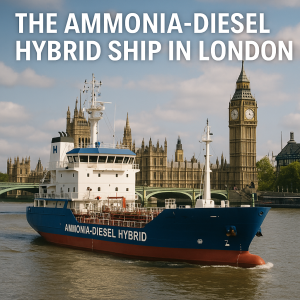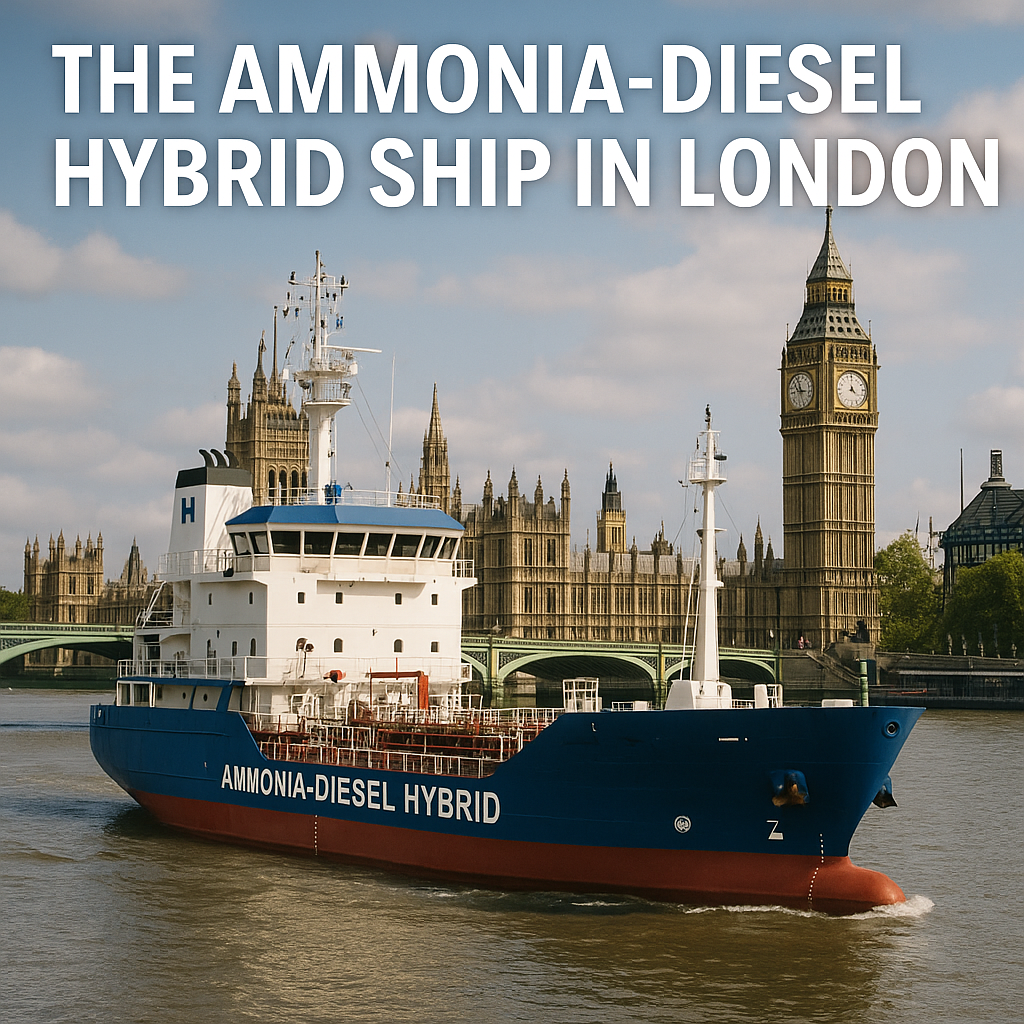Discover Fortescue’s groundbreaking ammonia-diesel hybrid ship in London. Learn how it is reshaping maritime decarbonization, challenges, and future trends.
 In July 2023, the River Thames witnessed something extraordinary: a commercial-sized ship running partly on ammonia — one of the first of its kind. Developed by Fortescue, the Australian mining and green energy company, this vessel was not just a technological prototype; it symbolized a turning point in the maritime industry’s transition toward cleaner fuels.
In July 2023, the River Thames witnessed something extraordinary: a commercial-sized ship running partly on ammonia — one of the first of its kind. Developed by Fortescue, the Australian mining and green energy company, this vessel was not just a technological prototype; it symbolized a turning point in the maritime industry’s transition toward cleaner fuels.
Shipping, responsible for nearly 3% of global greenhouse gas emissions, is under growing regulatory and public pressure to decarbonize. The launch of the ammonia-diesel hybrid ship in London signaled that alternative fuels are no longer just laboratory experiments but practical realities being tested in real-world conditions.
This article explores why Fortescue’s initiative matters, the innovations behind ammonia propulsion, challenges to adoption, real-world applications, and what the future holds for green shipping.
Why This Topic Matters in Maritime Operations
The maritime sector has long relied on heavy fuel oil (HFO) and marine diesel oil (MDO) to power global trade. While these fuels are cheap and energy-dense, they are also highly polluting, emitting sulfur oxides (SOx), nitrogen oxides (NOx), particulate matter, and vast amounts of carbon dioxide.
The International Maritime Organization (IMO) has set ambitious targets:
-
Reduce carbon intensity by at least 40% by 2030 compared to 2008 levels.
-
Achieve net-zero greenhouse gas emissions “by or around 2050.”
Meeting these goals requires new fuels, new technologies, and new mindsets. Among the contenders, ammonia stands out for several reasons:
-
Zero carbon molecule – Ammonia (NH₃) contains no carbon, meaning it can be burned without directly producing CO₂.
-
High energy density – Though lower than conventional fuels, ammonia has higher volumetric energy content than hydrogen.
-
Established global trade – Ammonia already has a vast production and shipping network for fertilizer and chemical industries.
Fortescue’s ammonia-diesel hybrid ship demonstrates how the maritime industry is beginning to merge fossil-based reliability with green innovation, providing a steppingstone toward full decarbonization.
Key Developments, Innovations, or Technologies
The Role of Fortescue in Green Shipping
Fortescue is traditionally known as an iron ore giant, but in recent years it has transformed itself into a green energy pioneer through its subsidiary, Fortescue Future Industries (FFI). The company’s vision extends beyond mining: it is investing heavily in green hydrogen, green ammonia, and renewable projects worldwide.
By converting one of its vessels into a hybrid ammonia-diesel ship and showcasing it in London, Fortescue sent a strong message to policymakers and industry leaders: the technologies for decarbonization exist — it is time for scaling.
How the Ammonia-Diesel Hybrid System Works
The Fortescue vessel employs a dual-fuel system capable of running on both diesel and ammonia.
-
Diesel Fuel Role: Provides ignition stability. Ammonia does not ignite easily under compression, so a small proportion of diesel acts as a “pilot fuel.”
-
Ammonia Fuel Role: Supplies the majority of propulsion energy. This drastically reduces CO₂ emissions.
-
Control Systems: Advanced monitoring ensures the right ammonia-diesel mix to balance performance, emissions, and safety.
This configuration allows the ship to operate reliably while lowering greenhouse gas emissions by up to 70–90% depending on the fuel mix.
Safety Engineering and Design Innovations
Ammonia is toxic and requires special handling. Fortescue and its partners addressed this through:
-
Double-walled piping to prevent leaks.
-
Gas detection sensors placed in engine rooms and cargo areas.
-
Ventilation systems for rapid dispersion in case of leaks.
-
Crew training protocols to ensure safe operations in line with IMO and classification society standards.
These measures are critical because the success of ammonia as a maritime fuel will depend not only on its emissions benefits but also on confidence in its safe use at scale.
Collaboration with Classification Societies
Fortescue worked closely with Lloyd’s Register and other classification societies to certify the hybrid system. Such collaboration ensures compliance with SOLAS safety rules, MARPOL emissions regulations, and IMO interim guidelines for alternative fuels.
This highlights a broader trend: shipowners cannot adopt alternative fuels in isolation. They require multi-stakeholder cooperation, including regulators, class societies, fuel suppliers, and ports.
Challenges and Practical Solutions
Despite its promise, ammonia propulsion faces several significant hurdles.
Fuel Availability and Infrastructure
-
Challenge: Although ammonia is widely produced for fertilizer, green ammonia — made using renewable energy instead of fossil fuels — remains scarce and expensive.
-
Solution: Fortescue and others are investing in large-scale green ammonia plants worldwide, including in Australia, the Middle East, and Europe. Scaling production is expected to lower costs by 2030.
Engine Technology Limitations
-
Challenge: Ammonia engines are still in the demonstration stage. Existing marine engines require retrofits or redesigns to handle ammonia’s combustion characteristics.
-
Solution: Companies like MAN Energy Solutions and Wärtsilä are actively developing ammonia-ready engines, with commercial availability projected within this decade.
Safety and Toxicity
-
Challenge: Ammonia exposure can be harmful to humans and marine life if released. Crew training and port safety protocols must evolve.
-
Solution: IMO and the International Association of Classification Societies (IACS) are drafting comprehensive ammonia bunkering and handling guidelines to standardize safety globally.
Economic Barriers
-
Challenge: Green ammonia currently costs 2–4 times more than marine diesel.
-
Solution: Carbon pricing mechanisms, government subsidies, and first-mover projects (like Fortescue’s ship) are bridging the gap until economies of scale reduce costs.
Case Studies / Real-World Applications
Fortescue’s Vessel in London
The public demonstration of Fortescue’s hybrid vessel on the River Thames in 2023 was not just symbolic; it was designed to influence policymakers ahead of IMO’s revised GHG strategy meeting.
By showcasing a working prototype, Fortescue illustrated that decarbonization is feasible — a powerful counter to arguments that the industry needs more time or exemptions.
Other Global Ammonia Pilot Projects
-
MAN Energy Solutions & Wärtsilä Demonstrators – Both companies have test engines running on ammonia, expected to scale by 2025–2026.
-
Yara and Aker Horizons (Norway) – Developing ammonia-powered short-sea shipping solutions.
-
Japan’s Shipping Giants (MOL, NYK, K Line) – Actively investing in ammonia-fueled newbuilds as part of Japan’s “Green Growth Strategy.”
-
Singapore Initiatives – As the world’s top bunkering hub, Singapore is studying ammonia bunkering pilot programs under its Maritime and Port Authority (MPA).
These initiatives collectively signal that ammonia is moving from concept to commercialization.
Future Outlook & Trends
The trajectory for ammonia as a maritime fuel is cautiously optimistic:
-
Short Term (2023–2027): Hybrid projects and demonstrators like Fortescue’s vessel will dominate. Safety standards and early bunkering trials will expand.
-
Medium Term (2027–2035): Widespread adoption on short-sea and regional shipping routes. Green ammonia costs expected to fall sharply as production scales.
-
Long Term (2035–2050): Potential mainstream adoption in deep-sea shipping, possibly replacing conventional fuels if global supply chains and regulations align.
Ammonia may not be the only solution. Instead, it will coexist with other fuels like methanol, biofuels, and hydrogen, depending on ship type, route, and economics. However, Fortescue’s hybrid vessel has already shown that ammonia deserves a front-row seat in the future of maritime decarbonization.
Frequently Asked Questions (FAQ)
1. Why is ammonia considered a zero-carbon fuel?
Because ammonia contains no carbon atoms, its combustion does not emit CO₂ directly.
2. Is ammonia safe for ships and crews?
Yes, with proper safeguards. Toxicity risks are managed through detection systems, ventilation, double-walled piping, and crew training.
3. How does an ammonia-diesel hybrid ship work?
The engine uses diesel as an ignition source while ammonia provides the bulk of energy, significantly lowering CO₂ emissions.
4. When will fully ammonia-powered ships be available?
Engine manufacturers project commercial availability before 2030, with pilot projects already underway.
5. Is green ammonia affordable compared to traditional fuels?
Currently, it is more expensive, but costs are expected to decline as production scales and carbon taxes incentivize alternatives.
6. Which countries are leading in ammonia shipping research?
Japan, Norway, Singapore, and Australia are at the forefront, supported by European research programs.
7. Will ammonia completely replace marine diesel?
Unlikely in the short term. It will likely complement other alternative fuels depending on vessel type and operational requirements.
Conclusion
The unveiling of Fortescue’s ammonia-diesel hybrid ship in London marks a watershed moment for maritime decarbonization. While challenges remain — from cost and infrastructure to safety and technology — the project demonstrates that alternative fuels are not distant dreams but operational realities.
As the shipping industry races against time to meet IMO’s climate goals, initiatives like Fortescue’s serve as beacons of possibility. They show that with innovation, collaboration, and bold investments, the maritime sector can chart a course toward a cleaner, greener future.
References
-
International Maritime Organization (IMO). (2023). IMO Greenhouse Gas Strategy.
-
Lloyd’s Register. (2023). Alternative Fuels and the Future of Shipping.
-
Wärtsilä Corporation. (2023). Ammonia as a Marine Fuel: Technology and Safety Outlook.
-
MAN Energy Solutions. (2022). Two-Stroke Ammonia Engine Development.
-
Fortescue Future Industries (FFI). (2023). Green Shipping Demonstration on the Thames.
-
Yara International & Aker Horizons. (2022). Ammonia for Shipping and Fertilizer.
-
UNCTAD. (2023). Review of Maritime Transport.
-
Marine Pollution Bulletin. (2022). Emerging Marine Fuel Pathways.
-
European Commission (DG MOVE). (2023). Sustainable and Smart Mobility Strategy.
-
The Maritime Executive. (2023). “Fortescue’s Ammonia Ship Demonstrates Future of Shipping.”
-
S&P Global. (2023). Alternative Fuels Cost Projections for Maritime.

